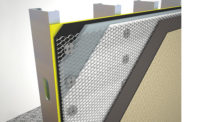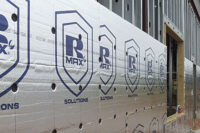As energy codes become more stringent, wall designs will continue to become increasingly more complex for both the residential and commercial market. Lath and plaster contractors have undoubtedly seen an increased demand in their projects for continuous insulation and tighter wall construction due to new energy code requirements resulting from ASHRAE 90.1 and Title 24.
These new energy code requirements have contractors and building designers alike often second guessing how to design a wall solution that ensures energy performance while still offering the aesthetics of stucco. Many who read that last sentence may instinctively be drawn to EIFS (which sometimes is the best solution) but for a myriad of reasons there is still and will always be a demand for traditional three coat stucco or lath and plaster base for adhered masonry. The key question is how to integrate continuous insulation with a durable three coat stucco cladding while still ensuring a weather tight building envelope. The extra layer of continuous insulation often necessitates a change in other components including the trim pieces, control joints, lath, lath fasteners, drainage membranes, the air/weather barrier, etc.
Stucco walls are constructed differently in different parts of the country and local labor may find it challenging to adapt to these changes. Given the complexity and the sheer number of unique building component options along with the impossibility of testing every conceivable configuration, the stucco industry will undoubtedly see a trend towards systemization. Systemization will consist of entire stucco wall solutions being clearly specified and detailed, fully tested, code compliant, and perhaps even warrantied.
Recently, I have had the privilege to work with a cross section group of industry experts to explore this exact issue. To my knowledge it was the largest and most complex “bi-partisan” study conducted with the goal of furthering the entire industries’ understanding of what works and what doesn’t.
This monumental collaboration was led by Tremco and included stucco wall component manufacturers, industry advisors and inspectors, lath and plaster bureau directors, and building science engineers. The group identified various commonly used components that would create a cross section sampling of commonly used materials and methods. They thought about the individual components that make up a stucco wall system including lath, WRBs, fasteners, flashings, trim pieces, control joints, insulation, etc.—the multitude of subtle variations available in the market adds up to thousands if not millions of possible unique wall configurations (which demonstrates the importance of wall systemization).
In the recently completed testing, the group designed and tested nine unique stucco wall assemblies each consisting of a different mix of components, accessories, and construction methods mentioned above. The large sampling of unique wall designs was intended to develop a baseline understanding of what works and what doesn’t.
Moisture Intrusion
Contractors don’t get calls at 3:00 a.m. from customers complaining that their walls are leaking air or leaking heat. Moisture intrusion is the primary reason for wall failure and 3:00 a.m. calls. Adding a layer of continuous insulation to a stucco assembly can pose new challenges for long term moisture resistance. Thicker insulation requires larger and longer lath fasteners to support the stucco cladding which in turn creates numerous penetrations of the air and weather barrier. In fact, recommended fastener spacing for traditional three coat stucco over 2-inches of insulation and exterior gypsum sheathing and into steel studs is every 6-inches vertically by 16-inches horizontally. That is a fastener every .667 square feet translating to 1,500 fasteners for every 1,000 square feet of lath.
Using tested and corrosion resistant fasteners, as well as lath and plaster, washers are a critical design element of any stucco assembly with ci. Keep in mind that the lath fasteners not only support the vertical shear load of the cladding weight, but in the event of stucco expansion and contraction it secures the cladding to the wall preventing buckling of the cladding. For this study, 1¼-inch diameter Grip-Plate Lath and Plaster washers along with number 10 diameter ceramic coated self-drilling screws were used to support the heavier cladding outboard of 2-inch thick rigid continuous insulation.
Big and observable leaks are not the hardest problems to solve in a leaky wall, rather it is the small, subtle, and unobservable leak hidden within a wall system that, when unnoticed, causes damage to the structure or mechanical systems. The most common test used in the wall industry to assess moisture penetration is ASTM E-331.
For those not familiar, the E-331 water penetration test consists of a full scale wall assembly. International Building Code Section 1403.2 references this test protocol at an increased duration of two hours (ordinary E-331 test is for 15 minutes duration) and an increased pressure differential of 6.24 psf (increased from 2.86 psf). This protocol requires a window opening, a soffit, a sill, and typical penetrations. For this test sequence nine unique 8-feet by 8-feet wall sections were constructed. The WRB is applied to the base wall structure and integrated with the window and pipe flashings.
In the case of a stucco test wall, the lath is applied along with the necessary control joints and terminations. The test wall bucks are strapped to a transparent wall and sealed around the perimeter. A calibrated and continuous amount of water is then sprayed on the outside surface of the wall assembly while a pressure differential is created inside of the wall simulating moisture drive through the assembly. Observers stand behind the transparent wall during the duration of the test to observe and notate any moisture migration through the wall assembly. A single drop of water penetration through the wall assembly constitutes a failure of E-331. It is important to note that E-331 is a pass/fail wall assembly test. Individual components are not tested; rather the entire assembly needs to function together without any leaks throughout the duration of the test.
The End Results
The group was pleased to see that many commonly available materials used in the various wall assemblies performed very well. Window penetrations and flashings were found to be critical in a stucco assembly with continuous insulation.
Bill Cardott of Tremco, who lead the group, says, “The effectiveness of flashing and connections made behind claddings is especially important. I was pleased that our Tremco solution for affecting simple, inexpensive flashing connections with Grade-D building paper at window openings and at duct penetrations, where used behind five of the stucco clad test walls, was proven to be effective in our aggressive water testing. The fluid-applied aspect of this flashing lends itself to any shape and size of opening and penetration.”
The 1¼-inch diameter Grip-Plate lath and plaster washers along with number 10 diameter ceramic coated self-drilling screws did a remarkable job of supporting the heavier cladding outboard of the 2-inch thick rigid continuous insulation. In fact, the group observed less hairline cracks of the stucco on walls that incorporated continuous insulation than the walls that did not.
There were several wall assemblies that resulted in small leaks, primarily due to moisture migration through control joints and around the wall test buck perimeter casing beads. Interestingly, some of these leaks were caused only once moisture penetrated behind the stucco cladding and built hydrostatic head between the surface of the WRB and the stucco where drainage was restricted. This finding highlights the importance of constructing a stucco wall that incorporates a drainage plane to create a channel for moisture to escape, to enhance and promote ventilation, and to prevent head pressure from building up behind the stucco.
A Systems Approach
As energy codes become more stringent, wall designs will continue to become increasingly more complex. Given the sheer number of building component options and the impossibility of testing every conceivable configuration, the stucco industry will undoubtedly see a trend towards systemization. Industry advancing studies and collaborative work is being spearheaded by building component manufacturers, lath & plaster bureaus, and building scientists with the goal of helping educate the industry on what works and what doesn’t. Architects, contractors, and subcontractors in our industry will succeed when they employ a “systems” approach to building their walls.


















